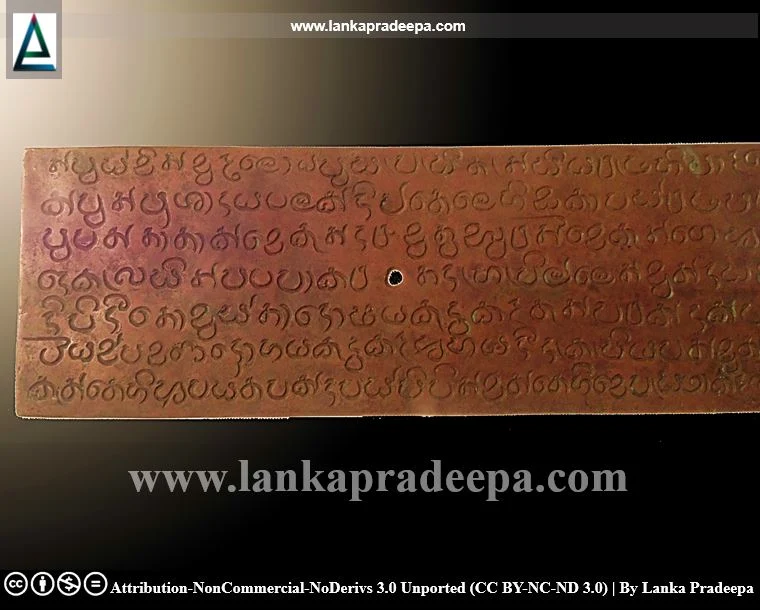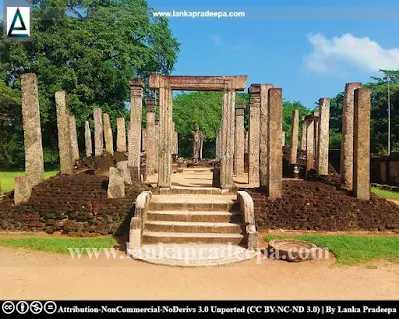
Vijayabahu I (Sinhala: පළමුවන විජයබාහු රජ; Tamil: முதலாம் விஜயபாகு) was the first king of Polonnaruwa Kingdom, Sri Lanka. He assumed kingship of the Principality of Rohana (or Ruhuna) in 1055 A.D. and became the king of the whole island in 1070 A.D. by expelling the South Indian Cholas. His reign lasted until his death in 1110 A.D.
Reign
Chola conquest of Anuradhapura (1017-1070 A.D.)
The Kingdom of Anuradhapura, the first kingdom of Sri Lanka fell into a politically unstable situation as Chola armies from South India tried to conquest it since the end of the 10th century. In 993 A.D. the Chola King Raja Raja I (c. 985-1014 A.D.) sent a large army to
Sri Lanka to conquest the kingdom. Raja Raja I's mission became successful during the reign of his son Rajendra Chola I (c.1014-1044 A.D.), as his armies could take King Mahinda V (982-1017 A.D.), the last king of
Anuradhapura as a captive to South India (see:
Fort Hammenhiel inscriptions) in 1917 A.D. After that, the Cholas established their rule in Polonnaruwa through a viceroy and renamed the city as Jananatha Mangalam
(Jayasuriya, 2016; Nicholas, 1963). They ruled the country for 53 years
until Vijayabahu I defeated them and
re-established the Sinhalese lineage in 1070 A.D.
Vijayabahu during the Chola period
Vijayabahu was born around 1040 (Wikramasinghe, 1928). The Panakaduwa Copper Plate Grant gives a brief account of his life as a youth in Galvala or Malaya-rata sometime before he ascended the throne in Rohana (Ranawella, 2007). Ambagamuwa Rock Inscription also reveals some information about Vijayabahu, his mother Devu gon-rajana and his father King Moggallana IV (1040-1055 A.D.) who is also known as Mugalan or Abasalamevan Maharajapa (Ranawella, 2007). According to chronicles, Moggallana IV was the son of Kassapa who was a son of a maternal uncle of Lokita, who was the younger of the two daughters of an unnamed maternal uncle of a king who ruled Sri Lanka for 16 years (Ranawella, 2007). This king is believed to be non-other than King Mahinda IV [(956-972 A.D.) Ranawella, 2007]. As is revealed by the Ambagamuwa rock inscription and Velaikkara Tamil Inscription, Vijayabahu I was a scion of the lineage of Iksvaku (Okkaka dynasty) of the Solar race (Ranawella, 2007).
The chronicle Mahavamsa mentions that Vijayabahu I was known during his boyhood as Kitti (Ranawella, 2007; Wikramasinghe, 1928). He dwelt in a village named Mulasala in Rohana and at the fifteen he took the title of Adipada [(governor) Wikramasinghe, 1928]. At the age of sixteen he attacked and killed Kesadhatu who held Rohana for six months and at seventeen he freed Rohana from all enemies and assumed kingship there by the title of Vijayabahu (Wikramasinghe, 1928).
Conquest of the Cholas & the King of Polonnaruwa
 In the fifteenth year of his reign as the ruler of Rohana, Vijayabahu I defeated the Cholas and entered Anuradhapura where he was crowned as the King of the whole island (Ray, 1960; Wikramasinghe, 1928). He celebrated his coronation as king at the newly built Palace at Anuradhapura but shortly
afterwards transferred the capital to Polonnaruwa (Nicholas, 1963; Ray, 1960).
Therefore, Vijayabahu I is considered the first king to establish
Polonnaruwa as the capital (Jayasuriya, 2016; Prematilaka & Hewage,
2018).
In the fifteenth year of his reign as the ruler of Rohana, Vijayabahu I defeated the Cholas and entered Anuradhapura where he was crowned as the King of the whole island (Ray, 1960; Wikramasinghe, 1928). He celebrated his coronation as king at the newly built Palace at Anuradhapura but shortly
afterwards transferred the capital to Polonnaruwa (Nicholas, 1963; Ray, 1960).
Therefore, Vijayabahu I is considered the first king to establish
Polonnaruwa as the capital (Jayasuriya, 2016; Prematilaka & Hewage,
2018). Changes were done in political, social, religious, and economic
aspects during this reign. He got down Buddhist monks from Myanmar to revive Buddhism in the country (Jayasuriya, 2016). However, the administrative success of Vijayabahu I was come to a virtual halt soon after his death due to the internal conflicts created by several contenders to the throne (Jayasuriya, 2016). Velaikkara Tamil Inscription gives some details about the Velaikkara revolt that erupted during the Vijayabahu's reign and about the problematic period that occurred soon
after the death of Vijayabahu I (Wickremasinghe, 1928).
After assuming the kingship of the whole country, he appointed his next younger brother Virabahu as the Uparaja of Dakkhinadesa while younger brother Jayabahu as the Adipada of the Rohana (Ray, 1960). Several revolts that occurred during this period were successfully cracked down by Vijayabahu. The rebellion organized by a commander named Adimalaya was quickly quelled in an action at Andu near Polonnaruwa and another rebellion started by three brothers who worked at Vijayabahu as the Chief of the Umbrella Bearers, the President of the Court of Justice, and Head of the Merchants was also settled by the troops of Vijayabahu (Ray, 1960).
Vijayabahu had two queens namely Lilavati and Tilokasundari (Ranawella, 2007). Lilavati was the daughter of the queen of Jagatipala of Oudh (or Vira-Salameghan of Kanauj), the former ruler of Rohana (1042-1046 A.D.) who together with his daughter had been taken prisoner by the Cholas after the defeat and death of her husband (Ray, 1960). Tilokasundari was his second Maheshi, brought from Kalinga, India (Ray, 1960). In order to strengthen the ties with India, Vijayabahu made a marriage alliance by giving his younger sister Mitta to a Pandya prince and exchanging envoys and gifts with the Kannata (Western Calukya) king (Ray, 1960).
By Lilavati, Vijayabahu had a daughter named Yasodhara (Ray, 1960). She married prince Viravamma and had two daughters, Lilavati and Sugala (Ray, 1960). Tilokasundari, the second Maheshi of Vijayabahu bore him five daughters (Subaddha, Sumitta, Lokanatha, Ratnavali and Rupavati) and a son named Vikramabahu (Ray, 1960). The sons of the Pandya prince by Vijayabahu's younger sister Mitta were Manabharana, Kittisirimegha and Sirivallabha (Ray, 1960).
Velaikkara revolt
In about 1085, a quarrel erupted between the Chola King Kulottunga I (1070-1122 A.D.) and Vijayabahu after several Sinhalese envoys were tortured in India by Cholas (Ray, 1960). Vijayabahu ordered and sent his army in two groups to the seaports of Mahatittha and Mattikavatatittha to begin the invasion of the Chola Kingdom (Ray, 1960). However, this mission was disrupted when the Velaikkara division (Tamil soldiers) of his army refused to fight against the Cholas in Tamil territory (Ray, 1960). Velaikkaras mutinied against Vijayabahu and captured the king's younger sister with her three sons and burnt down the Royal Palace (Ray, 1960; Wickremasinghe, 1928). Vijayabahu fled to the rock fortress at Vakirigala in Kegalle, collected and organized troops and fought back against Velaikkaras (Ray, 1960). He inflicted savage punishment on the Velaikkara leaders and accepted the submission of the survivors (Ray, 1960).
Death
Vijayabahu I ruled at Polonnaruwa for 40 years and died in the 41st year of his Polonnaruwa rule after he had kept his 73rd birthday festival (Wikramasinghe, 1928). He was succeeded by his younger brother Jayabahu.
Services & monuments
Religious
It is evident from the chronicles that Buddhism gradually declined under the Chola rule (Ranawella, 2007). As recorded in chronicles, after taking Mahinda V as a captive to South India, Cholas violently destroyed and plundered many Buddhist monasteries of all three fraternities in Sri Lanka like blood-sucking Yakkhas and took all the treasures of the country for themselves (Ranawella, 2007). Although, Vijayabahu I expelled the Cholas from the country he was unable to assemble a sufficient number of Buddhist monks to make the chapter full for the holding of the ceremony of Upasampada [(the act of higher ordination) Ranawella, 2007; Ray, 1960]. He sent messengers to King Anuruddha (Anawrahta Minsaw: 1044-1077 A.D.) of the Ramanna country (present Myanmar) to get a sufficient number of monks to restore the Upasampada and this religious act of Vijayabahu is well explained in the Velaikkara Tamil Inscription in Ancient Polonnaruwa City (Ranawella, 2007; Ray, 1960).
Several religious works carried out by Vijayabahu I are given below (Nicholas, 1963; Ranawella, 2007; Ray, 1960);
#) Devanagara Viharaya: Restored the temple.
#) Girikandaka Viharaya: Repaired the temple.
#) Jambukola Viharaya: Restored the Viharaya.
#) Jambukolalena Viharaya: Restored the Viharaya.
#) Kapara Mula: A massive image house was built by the daughter of Vijayabahu I.
#) Kasagala Viharaya: Restored the Viharaya.
#) Kurundiya Viharaya: Restored the temple.
#) Mahiyangana Viharaya: Restored the Viharaya and granted it villages.
#) Medirigiriya: Restored the Viharaya destroyed by Cholas.
#) Pancaparivenamula: Restored the monastery.
#) Paragamaka Viharaya: Restored the temple (unidentified).
#) Pathina Viharaya: Restored the temple which is presently known as Pethiyagala Viharaya.
#) Rakkhacetiyapabbata Vihara: Restored the Viharaya.
#) Sandagiri Viharaya: Restored the Viharaya.
#) Sitalaggama Viharaya: Restored the temple (unidentified).
#) Sri Pada Mountain: Offerings were made to the sacred footprint of the Buddha on Samanola mountain (Sri Pada mountain) and effected many improvements to that shrine. Charitable deeds were also made for the convenience of the pilgrims there.
#) Talavatthu Viharaya: Restored the temple.
#) Vijayaraja Iswaram: A Hindu temple probably built under the patronage of the king.
Social
Some of the social works carried out by Vijayabahu I are listed below (Nicholas, 1963);
#) Dighavatthuka Wewa: Restored the tank (unidentified).
#) Erandegala Wewa: Renovated the tank presently known as Inamaluwa Wewa.
#) Kalalahallika: The tank at this place was restored by Vijayabahu.
#) Kumbhilasobbhaka Wewa: Probably the Kumbalaka Wewa built by King Mahasena (275-301). Vijayabahu I restored it.
#) Madatugama Wewa: Restored the tank.
#) Maeliya Wewa: Restored the tank.
#) Mahadaragalla Wewa: Restored the tank (unidentified).
#) Mahakanadarawa Wewa: The tank was repaired, restored and improved.
#) Mandavataka Wewa: Restored the tank.
#) Minneriya Wewa: Restored the canal named Talavatu and fill the Minneriya tank.
#) Panda Wewa: Restored the tank.
#) Pattapasana Wewa: Restored the tank.
#) Sareheru Wewa: Restored the tank (unidentified).
#) Valahassavapi: Restored the tank (unidentified).
Inscriptions
About five medieval Sinhalese inscriptions dated in the reign of King Vijayabahu I have been found in places around Sri Lanka (Ranawella, 2007).
1) Panakaduwa Copper Plate Charter (from Matara District)
This inscription records a special grant pronounced by King Vijayabahu I
in council from the palace at the Anuradhapura in his
27th regnal year.
2) Ambagamuwa Rock Inscription (from Kandy District)
This inscription reveals the Vijayabahu I's victory over the Tamil forces (Colas) who dominated the northern half of the country at the time.
3) Gilimalaya Slab Inscription (from Ratnapura District)
This states about granting of the Gilimale village by Vijayabahu I for the benefit of the pilgrims who went to worship the sacred footprint of the Buddha on the peak of the Sri Pada Mountain.
4) Velgam Vehera slab inscription (from Trincomalee District)
This is a private document but it has adopted a regnal year of King Vijayabahu I for the purpose of dating the document.
5) Polonnaruwa slab inscription (from Polonnaruwa District)
This inscription is dated in the 55th regnal year (1110 A.D.) of King Vijayabahu I.
See also
References
1) Jayasuriya, E., 2016. A guide to the Cultural Triangle of Sri Lanka. Central Cultural Fund. ISBN: 978-955-613-312-7. pp.67-70.
2) Nicholas, C. W., 1963. Historical topography of ancient and medieval Ceylon. Journal of the Ceylon Branch of the Royal Asiatic
Society, New Series (Vol VI). Special Number: Colombo. Royal Asiatic
Society (Ceylon Branch). pp.46,48,61,68,70,80,83,86,99-100,102,108-109,144,167-168,174-180, 183,188,190-192.
3) Prematilaka, L., Hewage, R., 2018. A guide to the National Museum,
Colombo: Department of National Museum. ISBN: 978-955-578-035-3. p.19.
4) Ranawella, S., 2007. Inscription of Ceylon. Volume VI. Department of Archaeology. ISBN: 978-955-91-59-61-2. pp.xxii-xxvi,xxxiv-xxxv,l,lii-liii,1-14.
5) Ray, H.C. (Editor in chief), 1960. History of Ceylon: Vol. I: Part II. Ceylon University Press. Colombo. pp.428-437.
6) Wikramasinghe, D. M. D. Z., 1928. Epigraphia Zeylanica: Being
lithic and other inscriptions of Ceylon Vol II: London. Published for
the government of Ceylon by Humphrey Milford, pp.202-218.
This page was last updated on 14 January 2023


